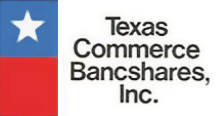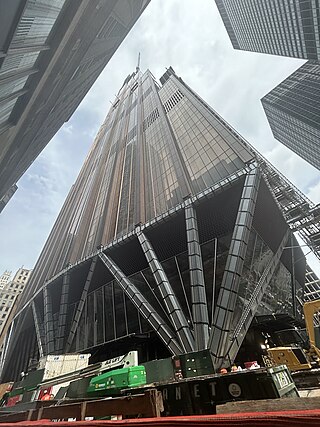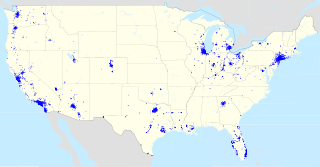
The Texas Commerce Bank was a Texas-based bank acquired by Chemical Banking Corporation of New York in May 1987. The acquisition of Texas Commerce Bank represented the largest interstate banking merger in history at the time with a purchase price of $1.2 billion. The bank had its headquarters in what is now the JPMorgan Chase Building in downtown Houston, Texas.
Chemical Bank was a bank with headquarters in New York City from 1824 until 1996. At the end of 1995, Chemical was the third-largest bank in the U.S., with about $182.9 billion in assets and more than 39,000 employees around the world.

JPMorgan Chase & Co. is an American multinational finance company headquartered in New York City and incorporated in Delaware. It is the largest bank in the United States and the world's largest bank by market capitalization as of 2023. As the largest of Big Four banks, the firm is considered systemically important by the Financial Stability Board. Its size and scale have often led to enhanced regulatory oversight as well as the maintenance of an internal "Fortress Balance Sheet". The firm is headquartered at 383 Madison Avenue in Midtown Manhattan and is set to move into the under-construction JPMorgan Chase Building at 270 Park Avenue in 2025.

JPMorgan Chase Bank, N.A., doing business as Chase, is an American national bank headquartered in New York City that constitutes the consumer and commercial banking subsidiary of the U.S. multinational banking and financial services holding company, JPMorgan Chase. The bank was known as Chase Manhattan Bank until it merged with J.P. Morgan & Co. in 2000. Chase Manhattan Bank was formed by the merger of the Chase National Bank and the Manhattan Company in 1955. The bank merged with Chemical Bank New York in 1996 and later merged with Bank One Corporation in 2004 and in 2008 acquired the deposits and most assets of Washington Mutual. In May 2023, it acquired the assets of First Republic Bank.

Wasserstein Perella & Co. was a boutique investment bank established by Bruce Wasserstein, Joseph R. Perella, Bill Lambert, and Charles Ward in 1988, former bankers at First Boston Corp., until its eventual sale to Dresdner Bank in 2000 for some $1.4 billion in stock. The private equity business of the investment firm was not included in the sale and was to be sold off to existing Wasserstein shareholders.
J.P. Morgan & Co. is an American financial institution specialized in investment banking, asset management and private banking founded by financier J. P. Morgan in 1871. Through a series of mergers and acquisitions, the company is now a subsidiary of JPMorgan Chase, one of the largest banking institutions in the world. The company has been historically referred to as the "House of Morgan" or simply Morgan.

Manufacturers Hanover Corporation was the bank holding company formed as parent of Manufacturers Hanover Trust Company, a large New York bank formed by a merger in 1961. After 1969, Manufacturers Hanover Trust became a subsidiary of Manufacturers Hanover Corporation. Charles J. Stewart was the company's first president and chairman.

Sir Dennis Weatherstone KBE was the former CEO and chairman of J. P. Morgan & Co. Born in London, he attended North Western Polytechnic. In 1946, at age 16, he was hired as a bookkeeper and was quickly promoted to the foreign exchange trading desk at the Guarantee Trust Company, a predecessor firm in London. Weatherstone rose through the ranks, becoming Morgan's chairman and CEO in 1991. He retired from J. P. Morgan in 1995 and was succeeded by Douglas "Sandy" Warner III.
Douglas 'Sandy' Warner is an American banker who joined Morgan Guaranty Trust Company of New York out of college in 1968 as an officer's assistant and rose through the ranks to become chief executive officer and chairman of the board of J.P. Morgan & Co. Inc. in 1995. Among his many accomplishments, Warner may be best known for spearheading the 2000 sale of J P Morgan & Co. to Chase Manhattan Bank for $30.9 billion.
The Manhattan Company was a New York bank and holding company established on September 1, 1799. The company merged with Chase National Bank in 1955 to form the Chase Manhattan Bank. It is the oldest of the predecessor institutions that eventually formed the current JPMorgan Chase & Co.
Don M. Wilson III is an American banker with expertise in corporate banking, global capital markets, and risk management. He was appointed as the first chief risk officer at JPMorgan Chase & Co. in 2003 and retired in 2006. He began his career in the management training program at Chemical Bank in New York in 1973 and later held senior executive positions in New York, Tokyo, and London.

CCMP Capital Advisors, LP is an American private equity investment firm that focuses on leveraged buyout and growth capital transactions. Formerly known as JP Morgan Partners, the investment professionals of JP Morgan Partners separated from JPMorgan Chase on July 31, 2006. CCMP has invested approximately $12 billion in leveraged buyout and growth capital transactions since inception. In 2007, CCMP was ranked #17 among the world's largest private equity funds.
David A. Coulter is an American banker.

John Francis McGillicuddy was an American banking industry executive who oversaw the merger between Manufacturers Hanover Trust and Chemical Bank in the early 1990s.
One Equity Partners is a private equity firm with over $10 billion in assets under management which primarily deals with the industrial, healthcare and technology sectors in North America and Europe. One Equity Partners was the merchant banking arm of JPMorgan Chase, focused on leveraged buyout and growth capital investments in middle-market companies. Formed by Bank One in 2001, the group has offices in New York City, Chicago, Sao Paulo, Vienna, Hong Kong and Frankfurt.
Thomas G. Labrecque served as a former President, CEO, and COO of Chase Manhattan Bank.
James Bainbridge Lee, Jr. was an American investment banker, notable for his role in the development of the leveraged finance markets in the U.S. in the 1980s. He is widely credited as the architect of the modern-day syndicated loan market. At the time of his death, Lee was vice chairman of JPMorgan Chase & Co. and a member of the bank's executive committee. He was also Co-Chairman of JPMorgan's investment bank.
Walter Vincent Shipley II was the chairman and chief executive officer of Chase Manhattan Bank and, previous to that, the company with which it merged Chemical Bank. Shipley was named chief executive of Chemical in 1981 and held the position through 1999 and remained at the bank as chairman through January 2000, just prior to the bank's merger with J.P. Morgan & Co. During his 18-year tenure, Shipley oversaw Chemical's mergers with Texas Commerce Bank in 1987, Manufacturers Hanover in 1991 and Chase Manhattan Bank in 1996.
JPMorgan Chase is an American multinational banking corporation with a large presence in the United Kingdom. The corporation's European subsidiaries J.P. Morgan Europe Limited, J.P. Morgan International Bank Limited and J.P. Morgan Securities plc are headquartered in London.
Jennifer Piepszak is an American financial executive and has been the Chief Financial Officer (CFO) of JPMorgan Chase since May 1, 2019. Her appointment was announced on April 17, 2019. She succeeded Marianne Lake, who was the CFO since 2012. Barron's named Piepszak one of the 100 Most Influential Women in U.S. Finance. Crain's New York named Piepszak the No. 2 Most Powerful Women in New York in 2019. American Banker named Piepszak the No. 4 Woman to Watch in 2018.






